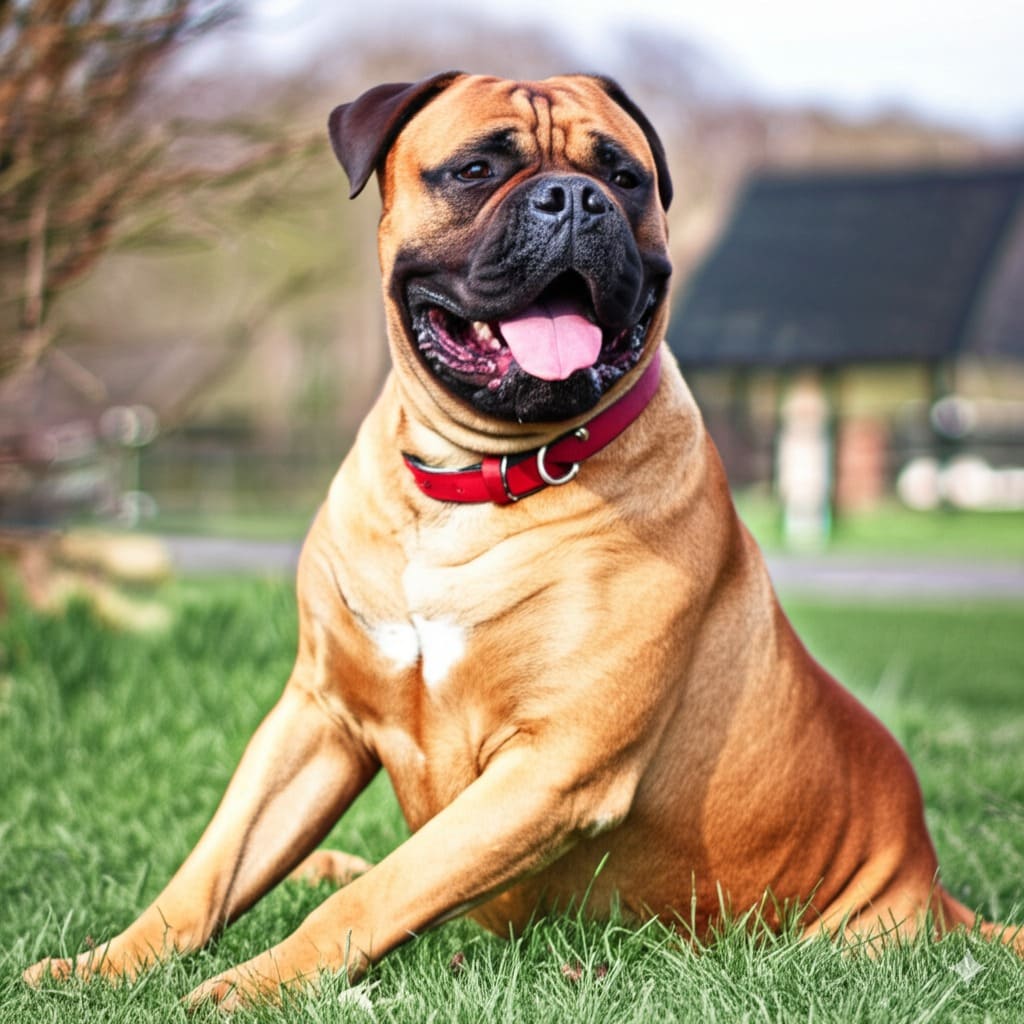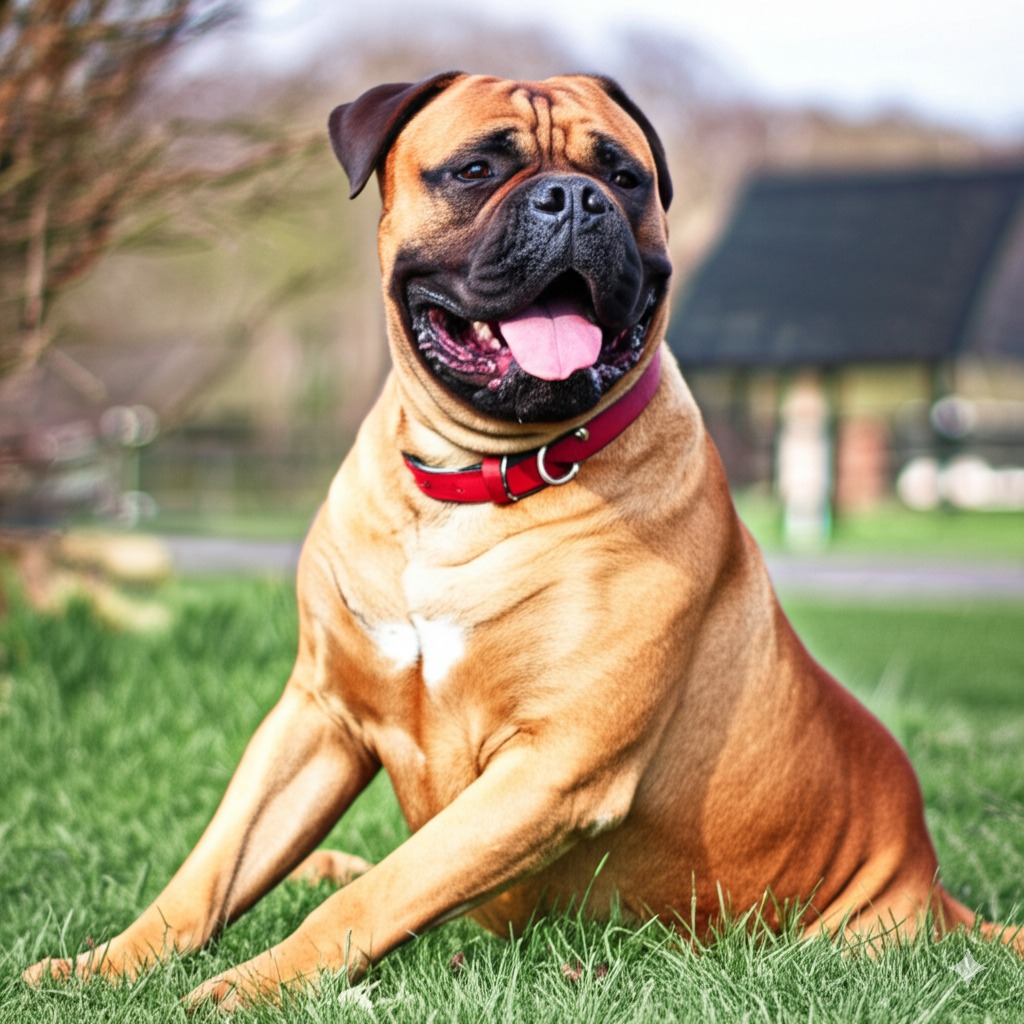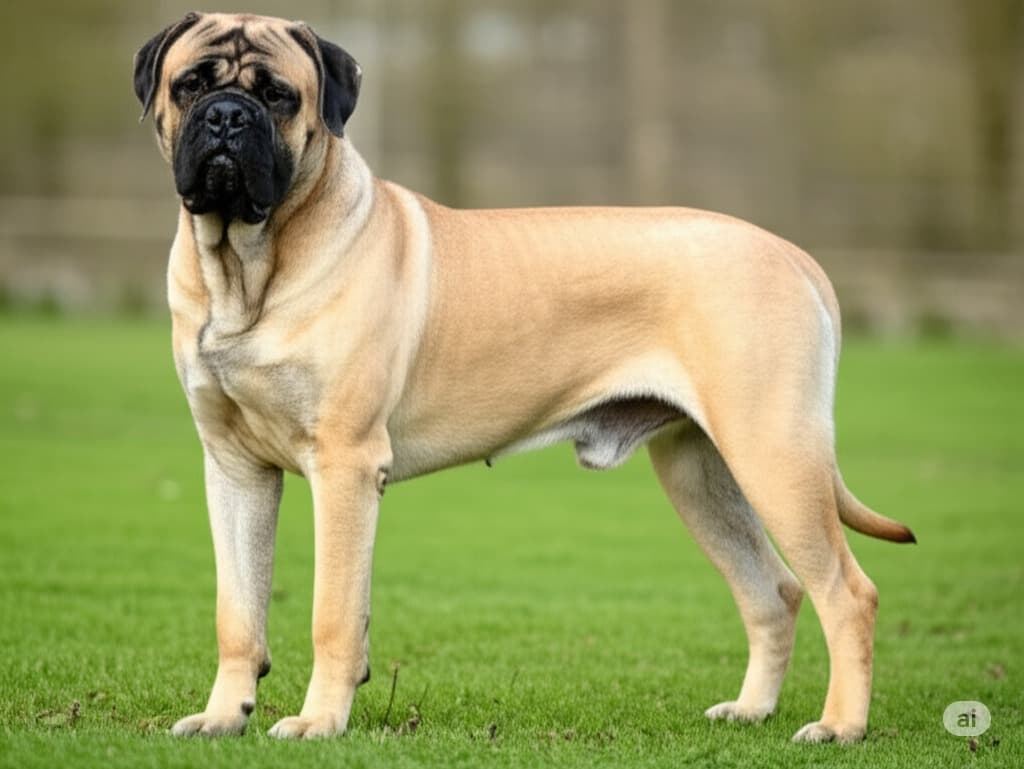
Bullmastiff
The Bullmastiff, a breed of imposing stature and steadfast character, stands as a testament to purposeful canine development. Originating in the vast estates of 19th-century England, this powerful dog was meticulously bred to serve as a silent and formidable guardian. Today, while still retaining its inherent protective instincts, the Bullmastiff has transitioned into a cherished family companion, known for its loyalty, affection, and surprisingly gentle nature within the home. This profile delves into the rich history, distinctive physical attributes, temperament, and care requirements of this remarkable breed, offering a comprehensive understanding for enthusiasts and potential owners alike.
Important Disclaimer:The information provided on this page about the Bullmastiff is intended for general knowledge and informational purposes only and does not constitute professional veterinary advice. Always consult with a qualified veterinarian for any health concerns or medical conditions related to your dog. The breed identification provided by our AI tool is a prediction and should not be considered a definitive diagnosis.
Bullmastiff Dog Breed Overview
- Breed Group
- Working, Guardian/Mastiff
- Origin
- England
- Purpose
- Estate Guardian (Gamekeeper's Dog), Protection
- Size
- Large
- Other Names
- Gamekeeper's Night Dog
- Lifespan
- 8-10 years (ranges vary 7-12.5 years)
- Temperament
- ReliableDevotedReservedProtectiveAlertDocileLoyalCalmPowerfulCourageousLoving
- Activity Level
- Low to Moderate
- Trainability
- Intelligent but can be independent/strong-willed
- Grooming
- Low (weekly brushing)
- Shedding
- Moderate (seasonal shedding)
- Barking
- Alert Watchdog (implies vocal when necessary, but not excessive)
- Good with
- Health Issues
- Shorter lifespan common in large breedsPotential joint issues (implied)Risk of overheating
- Suited For
- Owners seeking a loyal guardian
- Experienced dog owners
- Homes with space (secure yard recommended)
- Owners committed to early socialization and training
- Families, Children (supervised)
Bullmastiff History & Origin: Popularity of Bullmastiffs
The Bullmastiff, a breed of imposing stature and steadfast character, stands as a testament to purposeful canine development. Originating in the vast estates of 19th-century England, this powerful dog was meticulously bred to serve as a silent and formidable guardian. Today, while still retaining its inherent protective instincts, the Bullmastiff has transitioned into a cherished family companion, known for its loyalty, affection, and surprisingly gentle nature within the home. This profile delves into the rich history, distinctive physical attributes, temperament, and care requirements of this remarkable breed, offering a comprehensive understanding for enthusiasts and potential owners alike.

🐶 Bullmastiff's cute puppy
History of Bullmastiff
The documented history of the Bullmastiff begins in the 19th century in England. Gamekeepers on large estates needed a canine assistant to deter and apprehend rampant poachers. They crossbred the English Mastiff (approx. 60%) and the Old English Bulldog (approx. 40%) to create a dog with size, strength, agility, tenacity, and courage. The goal was a dog that could track silently, cover ground quickly, and pin poachers without mauling them.
The English Kennel Club recognized the breed in 1924, followed by the American Kennel Club (AKC) in 1933/1934, the United Kennel Club (UKC) in 1948, and the Fédération Cynologique Internationale (FCI) in 1955.
Purpose and Popularity of Bullmastiff
The Bullmastiff's original purpose was as the 'Gamekeeper's Night Dog,' silently guarding estates against poachers. They were also used to guard diamond mines in South Africa. While retaining protective instincts, they are now popular, loyal, and affectionate family companions.
In the US, the Bullmastiff's AKC popularity ranking has fluctuated slightly: 67th (2024), 60th (2023), 61st (2022), 56th (2021), and 55th (2020), indicating consistent interest.
Did you know?
The Bullmastiff earned the nickname 'Gamekeeper's Night Dog' because it was specifically bred to silently track and apprehend poachers on English estates under the cover of darkness.
Bullmastiff Dog Breed Size and Physical Traits
Size of Bullmastiff dog Breeds
Size Category
Large
Height
Male
25-27 inches (64-69 cm)
Female
24-26 inches (61-66 cm)
Weight
Male
110-130 lbs (50-59 kg)
Female
100-120 lbs (45-54 kg)
Appearance of Bullmastiff dog Breeds
- Coat Type
- Short, dense, weather-resistant coat
- Eye Size & Color
- Dark, medium-sized, alert and intelligent expression
- Ear Size & Shape
- V-shaped, set high, close to cheeks, darker than body
- Tail
- High-set, strong at root, tapering to hocks, carried straight or curved (not hound-like)
Description of Bullmastiffs Appearance

👀 How does Bullmastiff look like?
- The Bullmastiff presents an imposing physique, consistently described as large, muscular, and powerfully built.
- Key features of bullmastiffs include a broad, wrinkled head with a short, dark, square muzzle, dark medium-sized eyes, and V-shaped ears set high and close to the cheeks.
- Bullmastiffs males typically stand 25-27 inches and weigh 110-130 pounds, while females are slightly smaller at 24-26 inches and 100-120 pounds.
- Their coat is short and dense, appearing in fawn, red, or brindle, often with a dark mask.
- The tail of bullmastiffs is strong and tapers, carried straight or curved.
Coat Colors of Bullmastiff dogs
Distinctive Features of Bullmastiff dog breeds
- Bullmastiffs are large, muscular, and powerfully built
- Bullmastiffs have a broad, wrinkled head with a short, square muzzle
- Bullmastiffs have a short, square muzzle with a dark mask (approx. 1/3 head length)
- Bullmastiffs have short and dense coat which is also weather-resistant
- The eyes of bullmastiffs are dark and of medium size, contributing to an alert and intelligent expression
- Bullmastiffs have V-shaped ears set high and close to the cheeks (they are typically darker than the body)
Bullmastiff Environment, Barking, Trainability and More...
Barking Level of Bullmastiff
Bullmastiffs are alert watchdogs and will vocalize to warn of perceived threats, but they are not known for excessive nuisance barking.
Trainability of Bullmastiff
Bullmastiffs are intelligent but possess an independent and strong-willed nature. Early, consistent training using positive reinforcement is essential.
Energy Level of Bullmastiff
Bullmastiffs have low to moderate energy levels, requiring daily moderate exercise like brisk walks.
Friendly Environment Description of Bullmastiffs
- Bullmastiffs thrive in environments where they can be close to their families, as they form strong bonds and enjoy physical contact.
- They are adaptable to various living situations, provided their exercise and social needs are met.
- A securely fenced yard is important due to their size and protective instincts.
- Early socialization is crucial to help them differentiate between threats and non-threatening strangers or situations.
- However, they can be territorial and possessive , and same-sex aggression can be a concern

🏠 Bullmastiff dog breed in its home environment
Personality Traits of Bullmastiff dog breed
Nature
A compelling blend of strength and gentleness; fearless protectors yet calm and docile with family.
Affectionate
Highly affectionate with their families, forming strong bonds and enjoying closeness.
With Children
Generally good, especially when supervised. Their large size requires caution around very young children.
With Other Dogs
Can be accepting if well-socialized early, but potential for territoriality, possessiveness, and same-sex aggression exists.
With Strangers
Typically reserved and suspicious of strangers; early socialization is key.
Protective
Strong protective instincts make them excellent natural watchdogs.
Adaptability
Known for adaptability to different living situations if needs are met.
Bullmastiffs are good with:
Bullmastiff Dog Breed Care & Grooming Needs
Shedding Level of Bullmastiff
Bullmastiffs have a short coat but experience seasonal shedding, typically heavier in spring and fall. Weekly brushing is usually sufficient.
Grooming Needs of Bullmastiff
Minimal grooming needed. Weekly brushing, occasional baths, regular nail trims, ear cleaning, and dental care.
Grooming Tips
Brush weekly with a bristle brush or grooming mitt. Bathe occasionally, ensuring facial wrinkles are dried thoroughly. Clean V-shaped ears weekly to prevent infections. Trim nails regularly and maintain dental hygiene.
Drooling Frequency of Bullmastiff
Bullmastiffs are known to drool, especially after eating or drinking. Keep a towel handy.
Bullmastiffs Daily Exercise Requirements
Minimum Daily Activity of Bullmastiff
30-60 minutes per day
Bullmastiffs require daily moderate exercise like brisk walks or playtime in a secure yard. They are not suited for long-distance running because of their large size. Also, they can overheat relatively easily and may not have the stamina for prolonged endurance activities. They are not ideally suited as running partners for long distances. For bullmastiffs, it is important to avoid over-exercising puppies during growth to protect their developing bones and joints.
Recommended Activities for Bullmastiffs
Living Space Compatibility of Bullmastiffs
Yard Requirement
A securely fenced yard is crucial to safely contain the dog and manage territorial instincts. If any intrusions are detected, that can trigger their protective instincts.
Apartment Living: Not Ideal
Can adapt to apartment living if sufficient daily exercise and mental stimulation are provided, but their large size needs adequate space.
Living Considerations for Bullmastiffs
- Requires early and ongoing socialization.
- Needs consistent training due to potential stubbornness.
- Drooling is common.
- Can be prone to overheating.
- Potential for same-sex dog aggression if not socialized properly.
- Large size requires management, especially around small children.
Bullmastiff Dog Lifespan and Health Issues
Average Lifespan of Bullmastiffs
Common Health Issues of Bullmastiffs
Bloat (Gastric Dilatation-Volvulus - GDV)
Common concern in large, deep-chested breeds (Implied risk, not explicitly stated in source text).
Hip and Elbow Dysplasia
Common orthopedic issue in large breeds (Implied risk, not explicitly stated).
Heart Problems (e.g., Cardiomyopathy)
Certain heart conditions can affect large breeds (Implied risk, not explicitly stated).
Cancer (e.g., Lymphoma, Osteosarcoma)
Some cancers are more prevalent in the breed (Implied risk, not explicitly stated).
Hypothyroidism
Underactive thyroid condition (General large breed risk, not explicitly stated for Bullmastiff in source).
Eye Problems (e.g., Entropion, Ectropion)
Eyelid issues can occur (General large breed risk, not explicitly stated for Bullmastiff in source).
Skin Issues/Allergies
Wrinkles can trap moisture leading to irritation (Implied by grooming advice).
Preventative Care of Bullmastiffs
- Choose breeders who screen for relevant health conditions.
- Provide appropriate exercise, avoiding overexertion, especially in heat.
- Maintain a healthy weight.
- Regular veterinary check-ups and vaccinations.
- Consistent grooming, including ear and wrinkle cleaning.
- Early socialization and training for mental well-being.
- Bathing is only needed occasionally, perhaps once a month or when they get particularly dirty. It is important to thoroughly dry them after bathing, especially within their facial wrinkles, to prevent skin irritation.
What to feed Bullmastiff? Bullmastiff's diet and Nutrition
Recommended Diet for Bullmastiff dog breed
High-quality commercial dog food formulated for large breeds, appropriate for their age (puppy, adult, senior) and activity level. Consult with a vet for specific recommendations.
Typical Feeding Schedule of Bullmastiffs
| Age Group | Feeding Frequency |
|---|---|
| Puppies (under 6 months) | 3 meals/day |
| Adolescents (6-12 months) | 2 meals/day |
| Adults | 2 meals/day (recommended to reduce bloat risk) |
| Seniors | 2 smaller meals/day, potentially adjusting formula for senior needs |
Sensitivities & Considerations of Bullmastiffs
Potential Food Sensitivities of Bullmastiffs
No specific breed-wide sensitivities mentioned, but individual dogs can develop allergies. Monitor for signs of digestive upset or skin issues.
Dietary Considerations of Bullmastiffs
- Large breed puppy formulas are crucial to manage growth rate and prevent orthopedic issues.
- Monitor weight closely to prevent obesity, which strains joints.
- Consider raised feeders or slow-feeder bowls if recommended by a vet (Bloat precaution).
- Ensure constant access to fresh, clean water.
- Drooling after eating/drinking is common.
Weight Management of Bullmastiffs
Maintaining a lean body condition is vital for joint health and overall longevity in this large breed.
Signs of Healthy Weight of Bullmastiffs
- Easily palpable ribs with a slight fat cover.
- Visible waistline when viewed from above.
- Abdomen tucked up when viewed from the side.
Tips for Healthy Feeding of Bullmastiffs
- Measure food accurately.
- Adjust portions based on age, activity level, and body condition.
- Limit treats.
- Avoid exercise immediately before or after meals (Bloat precaution).
- Consult your veterinarian for personalized diet advice.
Is Bullmastiff a good match for you?
Bullmastiffs are best suited for experienced dog owners who understand large, powerful breeds and are prepared for their protective nature, training needs, and physical requirements. They need a confident leader who can provide structure, socialization, and affection.
Bullmastiffs are a Great Match For
- Experienced owners of large/guardian breeds
- Individuals or families seeking a loyal, protective companion
- Owners committed to consistent training and early socialization
- Households that can provide moderate exercise (walks, secure yard)
- People who appreciate a calm, affectionate dog within the home
- Those prepared for drool and large-dog management
Bullmastiffs May be Challenging For
- First-time dog owners
- Individuals seeking a highly active or athletic canine partner
- Owners unable or unwilling to provide consistent training and socialization
- Those living in small spaces without commitment to sufficient exercise
- People uncomfortable with a large, powerful, potentially dominant dog
- Households unprepared for drool or potential dog aggression issues
- Owners looking for a dog that is naturally welcoming to all strangers



